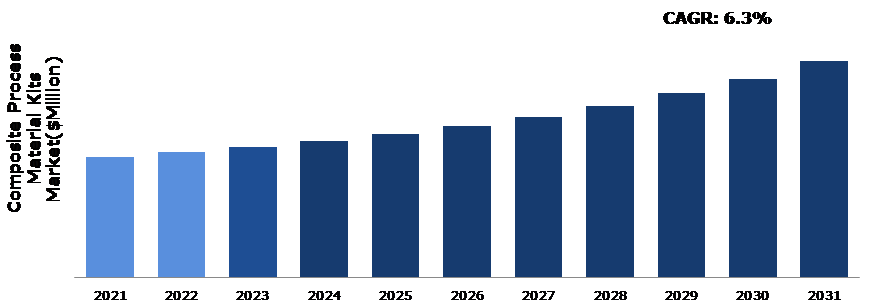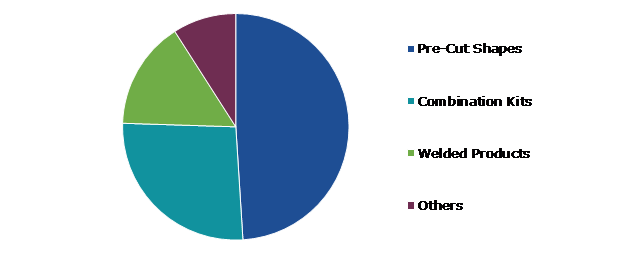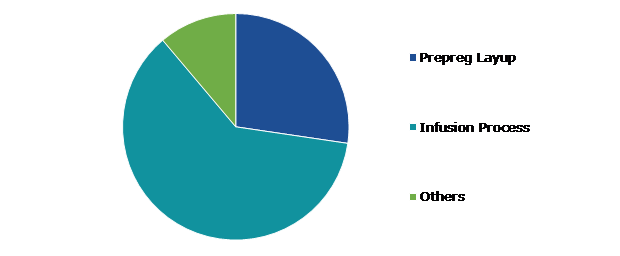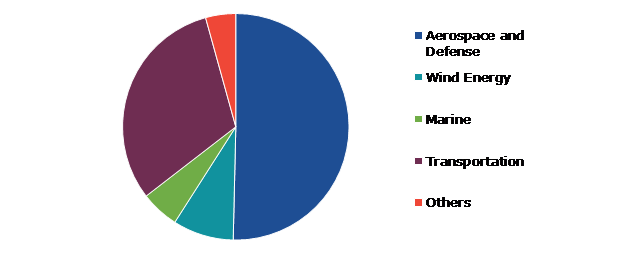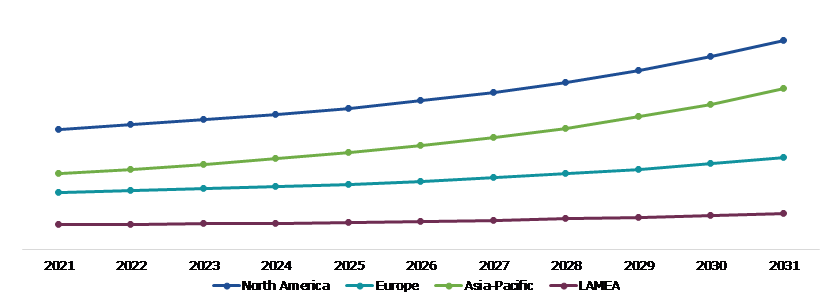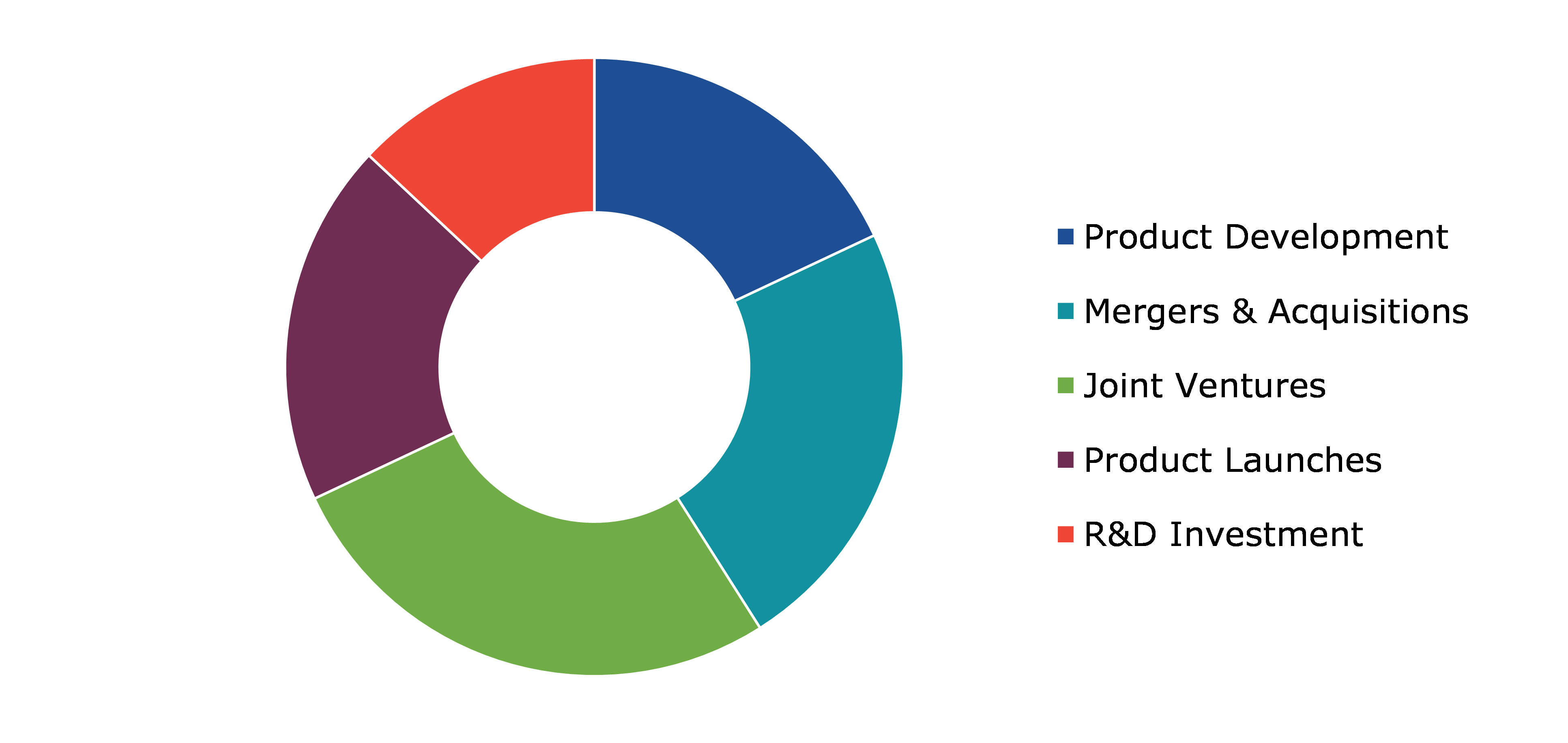Composite Process Material Kits Market Report
RA08598
Composite Process Material Kits Market by Kit-Type (Pre-Cut Shapes, Combination Kits, Welded Products, and Others), Process-Type (Prepreg Layup, Infusion Process, and Others), End-use Industry (Aerospace & Defense, Wind Energy, Marine, Transportation, and Others), and Regional Analysis (North America, Europe, Asia-Pacific, and LAMEA): Global Opportunity Analysis and Industry Forecast, 2022-2031
Global Composite Process Material Kits Market Analysis
The Global Composite Process Material Kits Market Size was $109.4 million in 2021 and is predicted to grow with a CAGR of 6.3%, by generating a revenue of $196.5 million by 2031.
Global Composite Process Material Kits Market Synopsis
Composite process materials are created by combining two or more materials with disparate qualities to create a material that is unique from the sum of its parts. The combination frequently removes or lessens the shortcomings of separate components, and each material imparts its distinctive qualities. One of the major advantages of composite process material is the light weight of composite materials which is their main benefit. Composite materials may significantly reduce an aircraft's weight, improving both performance and fuel economy. In most airplanes, fiber-reinforced matrix technologies offer a smoother, more aerodynamic surface that increases performance and fuel economy while also being stronger than typical aluminum. Composite materials do not corrode as quickly as other forms of construction do, and unlike aluminum, they do not break from metal fatigue. As a result of their flexibility, they outlast metal, which results in fewer maintenance and repair expenses. These factors are anticipated to boost the composite process material industry growth in the upcoming years.
However, some of the disadvantages of composite process material such as strict environmental regulations, higher expenses, and limits for waste disposal—are just a few of the market dynamics that are limiting the market. Additionally, composite end-of-life waste management is coming under close examination due to the growing use of life cycle assessment as a component of the material selection process in several sectors. For instance, the sector must address substantial societal and industrial difficulties because it is estimated that 90% of garbage in the UK now ends up in landfills. Furthermore, the rise in plastic garbage has forced governments all over the world to enact strict environmental regulations. A ban on single-use plastic in some nations has drawn attention to the measures adopted by governments to address the issues raised by plastic trash.
The increased usage and applications of advanced composite materials will also be seen in the defense industry. There are additional novel uses that will help the military industry, even though many of these will be in the form of airframe components because of their light weight and strength, for instance, are used by Morgan Advanced Materials (MAM) to create lightweight armor items including helmets, vests, and ballistic protection jackets. According to MAM, their armor offers integrated threat protection from mine blasts, flaming fluids, and fragmentation while being 50% lighter than the equivalent structural model.
According to regional analysis, the North America composite process material kits market accounted for heighted market share in the projected timeframe. Due to the presence of numerous small to large-sized OEMs, molders, process material suppliers, and raw material suppliers, the region has been a pioneer in the advanced composites industry.
Composite Process Material Kits Market Overview
Composite process material kits are created by combining two or more materials with different features to create a material that is unique from the sum of its parts. The combination frequently removes or lessens the shortcomings of separate components, and each material imparts its distinctive qualities. It is possible to decide in advance what a material's qualities will be. Fewer raw materials, fasteners, and joints are needed for composite process materials, and this flexibility during the production process results in a range of features.
COVID-19 Impact on Global Composite Process Material Kits Market
The COVID-19 pandemic has brought several uncertainties leading to severe economic losses as various businesses across the world were standstill. This has ultimately lowered the demand for composite process material kits due to disruptions in supply chain, closure of manufacturing plants, as well as economic slowdown across several countries. In addition, the import-export restrictions were laid down on major composite process material kits producing countries such as the U.S. and China. For instance, sanitization of goods being imported from China was imposed by several countries. In addition, the construction & automotive sector faced the highest impact in terms of sales and acquisition of new projects due to which the composite process material kits demand reduced significantly. For instance, in construction industry, several construction projects were postponed or cancelled due to shortage of raw materials and laborers, fear of contracting the COVID-19 virus among workers, as well as travel restrictions. Similarly, in the automotive sector, composite process material kits are used in spark-ignition engines. However, disruptions in the exports of automotive parts from China as well as closure of automotive assembly and manufacturing units have hampered the composite process material kits market share during the pandemic. These initiatives are predicted to drive the composite process material market size during the analysis timeframe.
Growing Applications of Composite Process Material Kits in Automotive Sector to Drive the Market Growth
The automotive industry is always developing composites for lightweight materials since fuel efficiency and pollution restrictions are so important. For example, as of right now, the Corporate Average Fuel Economy (CAFÉ) rules in the US need a fleet average of 23.2 km/liter by 2025. A fleet goal of 20 km/liter is also established by China's Corporate Average Fuel Consumption (CAFC). In 2021, CO2 emissions must be 95 g/km, and they must further decrease by 15% by 2025, according to European emission laws. Currently, more than 100 types of automobiles call for the use of carbon-fiber-reinforced plastic in the manufacture of original equipment manufacturer (OEM) parts. The industry is also being stimulated by the expanding trend of thermoplastics being used in vehicles. These materials are being used by the original equipment manufacturers (OEMs) to produce lighter automobiles, emit fewer pollutants, and have better fuel economy. Increase in the use of composite process material kits market for automotive sector application is expected to boost the composite process material kits market share.
To know more about global composite process material market drivers, get in touch with our analysts here.
Lack of Standardization in Manufacturing Technologies Over Composite Process Material Kits to Restrain the Market Growth
The use of composites in a variety of applications, including sports goods, marine, and consumer products, is furthermore constrained by manufacturing and non-recurring development expenses. The key problems of concern are design consistency, process standardization, and maintenance technology. The manufacturers are forced to use conservative designs due to the lack of material and methodology standardization, which hinders the mass manufacturing and financial viability of vehicles and airplanes. Additionally, fewer people with composites-related training and expertise prevent composites from being used in more applications which is anticipated to hamper the composite process material market growth.
Use of Composite Process Material Kits as an Aerospace Sector to Drive Excellent Opportunities
Composite materials are critical to UK aerospace and to the industry's future success in the markets for whole aircraft, aerostructures, propulsion, and systems due to their capacity to offer top-notch alternatives for a variety of goods. Understanding future demands, promoting technology, and facilitating capability development in composites are crucial for the UK. This document provides the industry with information on current composite advances in the UK and on future demands by providing comprehensive research to evaluate composite technologies. The objectives of the subjects are to help with the creation of cooperative industrial research initiatives that place the UK aerospace composites sector in a competitive position to benefit from developing high-value global aerospace opportunities. Increase in the use of the composite process material kits market for aerospace applications are anticipated to boost the market.
To know more about global composite process material market opportunities, get in touch with our analysts here.
Global Composite Process Material Kits Market, by Kit-Type
Based on kit-type, the market has been divided into pre-cut shapes, combination kits, welded products, and others. Among these, the pre-cut shapes sub-segment accounted for the highest market share in 2021 and it is estimated to show the fastest growth during the forecast period.
Global Composite Process Material Kits Market Size, by Kit-Type, 2021
Source: Research Dive Analysis
The Pre-Cut Shapes sub-type is anticipated to have a dominant market share in 2021 as well as is anticipated to show the fastest growth. The market's most popular kit type is a pre-cut shape, while welded kits are predicted to increase at the highest rate in the coming years. Wind turbine blades are made from pre-cut shaped kits. They are simple to handle, which reduces the need for mechanical lifting equipment and, eventually, lowers costs. To facilitate the fiber architecture, the material needs to be first pre-cut into patterns. The materials are then spread out over a surface, then compressed and debulked by a mandrel rolling over them.
Global Composite Process Material Kits Market, by Process-Type
Based on process-type, the market has been divided into prepreg layup, infusion process, and others. Among these, the infusion process sub-segment accounted for highest revenue share in 2021.
Global Composite Process Material Kits Market Forecast, by Process-Type, 2021
Source: Research Dive Analysis
The Infusion Process sub-segment is anticipated to have a dominant market share in 2021. An innovative method for creating composite materials is infusion molding. It involves inserting dry reinforcements in a mold that is covered by a vacuum bag; the reinforcements are then impregnated with resin, which is introduced into the mold and sucked up by the depression it creates. The use of a defined amount of resin results in a greater fiber rate, a superior strength-to-weight ratio, the manufacture of big components in a single phase, and the repeatability of the products. These factors are anticipated to boost the growth of infusion process sub-segment during the analysis timeframe.
Global Composite Process Material Kits Market, by End-use Industry
Based on end-use industry, the market has been divided into aerospace & defense, wind energy, marine, transportation, and others. Among these, the aerospace and defense sub-segment accounted for highest revenue share in 2021.
Global Composite Process Material Kits Market Share, by End-use Industry, 2021
Source: Research Dive Analysis
The Aerospace & Defense sub-segment is anticipated to have a dominant market share in 2021. Companies that specialize in aerospace and defense (A&D) produce weapons systems, ships, spacecraft, and defense hardware. They offer their goods to both public and private organizations, although the needs of the former often determine the priorities for product development. Many of these businesses are state-owned or state-influenced to some extent, and some of them were born out of P3s or the privatization of government operations. These factors are anticipated to boost the growth of aerospace & defense sub-segment during the analysis timeframe.
Global Composite Process Material Kits Market, Regional Insights
The composite process material kits market was investigated across North America, Europe, Asia-Pacific, and LAMEA.
Global Composite Process Material Kits Market Size & Forecast, by Region, 2021-2031 (USD Million)
Source: Research Dive Analysis
The Market for Composite Process Material Kits in North America to be the Most Dominant
North America is anticipated to dominate the global composite process material kits market during the forecast period. Due to the presence of several small to large-sized OEMs, molders, process material suppliers, and raw material suppliers, the area has been a pioneer in the advanced composites sector. Due to the range of types, production flexibility, and broad usage in several applications, the market for composite process materials appears to be growing in a positive direction. The U.S. has experienced rapid expansion and is a top manufacturer of composite materials. Many businesses are partnering with American producers to establish factories. For instance, the development of a new plant was announced in cooperation with Owens Corning and Chongqing Polycomp International Corp. (CPIC). This plant will include a glass furnace with a 110,000 metric tonne annual production capacity and is designed to produce high-modulus glass fiber products in the U.S.
Competitive Scenario in the Global Composite Process Material Kits Market
Investment and agreement are common strategies followed by major market players. For instance, in December 2020, the U.S. company Composites One (Arlington Heights, Illinois) announced the creation of a significant partnership with 3M Aerospace (St. Paul, Minn., U.S.). This agreement is expected to enable Composites One to keep supplying the aerospace industry with the film adhesives, primers, and surface protection solutions that 3M specifies for OEMs.
Source: Research Dive Analysis
Some of the leading composite process material kits market players are Airtech Advanced Materials Group, Aerovac Composites One, Shanghai Leadgo-Tech Co., Ltd., Diatex SAS, InCom Group, Metyx Composites, GEFiM, Pro-Vac Vacuum Consumables, Velocity Composites plc, and Solvay S.A.
| Aspect | Particulars |
| Historical Market Estimations | 2020 |
| Base Year for Market Estimation | 2021 |
| Forecast Timeline for Market Projection | 2022-2031 |
| Geographical Scope | North America, Europe, Asia-Pacific, and LAMEA |
| Segmentation by Kit Type
|
|
| Segmentation by Process Type
|
|
| Segmentation by End-use Industry |
|
| Key Companies Profiled |
|
Q1. What is the size of the global composite process material kits market?
A. The size of the global composite process material kits market was over $109.4 million in 2021 and is projected to reach $196.5 million by 2031.
Q2. Which are the major companies in the composite process material kits market?
A. Airtech Advanced Materials Group, Aerovac Composites One, and Shanghai Leadgo-Tech Co., Ltd. are some of the key players in the global composite process material kits market.
Q3. Which region, among others, possesses greater investment opportunities in the near future?
A. The Asia-Pacific region possesses greater investment opportunities for investors to witness the most promising growth in the future.
Q4. What will be the growth rate of the Asia-Pacific composite process material kits market?
A. Asia-Pacific composite process material kits market is anticipated to grow at 8.0% CAGR during the forecast period.
Q5. What are the strategies opted by the leading players in this market?
A. Agreement and investment are the two key strategies opted by the operating companies in this market.
Q6. Which companies are investing more on R&D practices?
A. Diatex SAS, InCom Group, and Metyx Composites are the companies investing more on R&D activities for developing new products and technologies.
1.Research Methodology
1.1.Desk Research
1.2.Real time insights and validation
1.3.Forecast model
1.4.Assumptions and forecast parameters
1.5.Market size estimation
1.5.1.Top-down approach
1.5.2.Bottom-up approach
2.Report Scope
2.1.Market definition
2.2.Key objectives of the study
2.3.Report overview
2.4.Market segmentation
2.5.Overview of the impact of COVID-19 on Global composite process material kits market
3.Executive Summary
4.Market Overview
4.1.Introduction
4.2.Growth impact forces
4.2.1.Drivers
4.2.2.Restraints
4.2.3.Opportunities
4.3.Market value chain analysis
4.3.1.List of raw material suppliers
4.3.2.List of manufacturers
4.3.3.List of distributors
4.4.Innovation & sustainability matrices
4.4.1.Technology matrix
4.4.2.Regulatory matrix
4.5.Porter’s five forces analysis
4.5.1.Bargaining power of suppliers
4.5.2.Bargaining power of consumers
4.5.3.Threat of substitutes
4.5.4.Threat of new entrants
4.5.5.Competitive rivalry intensity
4.6.PESTLE analysis
4.6.1.Political
4.6.2.Economical
4.6.3.Social
4.6.4.Technological
4.6.5.Environmental
4.7.Impact of COVID-19 on the composite process material kits market
4.7.1.Pre-covid market scenario
4.7.2.Post-covid market scenario
5.Composite Process Material Kits Market Analysis, by Kit Type
5.1.Overview
5.2.Pre-Cut Shapes
5.2.1.Definition, key trends, growth factors, and opportunities
5.2.2.Market size analysis, by region
5.2.3.Market share analysis, by country
5.3.Combination Kits
5.3.1.Definition, key trends, growth factors, and opportunities
5.3.2.Market size analysis, by region
5.3.3.Market share analysis, by country
5.4.Welded Products
5.4.1.Definition, key trends, growth factors, and opportunities
5.4.2.Market size analysis, by region
5.4.3.Market share analysis, by country
5.5.Others
5.5.1.Definition, key trends, growth factors, and opportunities
5.5.2.Market size analysis, by region
5.5.3.Market share analysis, by country
5.6.Research Dive Exclusive Insights
5.6.1.Market attractiveness
5.6.2.Competition heatmap
6.Composite Process Material Kits Market Analysis, by Process-Type
6.1.Prepreg Layup
6.1.1.Definition, key trends, growth factors, and opportunities
6.1.2.Market size analysis, by region
6.1.3.Market share analysis, by country
6.2.Infusion Process
6.2.1.Definition, key trends, growth factors, and opportunities
6.2.2.Market size analysis, by region
6.2.3.Market share analysis, by country
6.3.Others
6.3.1.Definition, key trends, growth factors, and opportunities
6.3.2.Market size analysis, by region
6.3.3.Market share analysis, by country
6.4.Research Dive Exclusive Insights
6.4.1.Market attractiveness
6.4.2.Competition heatmap
7.Composite Process Material Kits Market Analysis, by End-use Industry
7.1.Aerospace & Defense
7.1.1.Definition, key trends, growth factors, and opportunities
7.1.2.Market size analysis, by region
7.1.3.Market share analysis, by country
7.2.Wind Energy
7.2.1.Definition, key trends, growth factors, and opportunities
7.2.2.Market size analysis, by region
7.2.3.Market share analysis, by country
7.3.Marine
7.3.1.Definition, key trends, growth factors, and opportunities
7.3.2.Market size analysis, by region
7.3.3.Market share analysis, by country
7.4.Transportation
7.4.1.Definition, key trends, growth factors, and opportunities
7.4.2.Market size analysis, by region
7.4.3.Market share analysis, by country
7.5.Others
7.5.1.Definition, key trends, growth factors, and opportunities
7.5.2.Market size analysis, by region
7.5.3.Market share analysis, by country
7.6.Research Dive Exclusive Insights
7.6.1.Market attractiveness
7.6.2.Competition heatmap
8.Composite Process Material Kits Market, by Region
8.1.North America
8.1.1.U.S.
8.1.1.1.Market size analysis, by Kit Type
8.1.1.2.Market size analysis, by Process Type
8.1.1.3.Market size analysis, by End-use Industry
8.1.2.Canada
8.1.2.1.Market size analysis, by Kit Type
8.1.2.2.Market size analysis, by Process Type
8.1.2.3.Market size analysis, by End-use Industry
8.1.3.Mexico
8.1.3.1.Market size analysis, by Kit Type
8.1.3.2.Market size analysis, by Process Type
8.1.3.3.Market size analysis, by End-use Industry
8.1.4.Research Dive Exclusive Insights
8.1.4.1.Market attractiveness
8.1.4.2.Competition heatmap
8.2.Europe
8.2.1.Germany
8.2.1.1.Market size analysis, by Kit Type
8.2.1.2.Market size analysis, by Process Type
8.2.1.3.Market size analysis, by End-use Industry
8.2.2.UK
8.2.2.1.Market size analysis, by Kit Type
8.2.2.2.Market size analysis, by Process Type
8.2.2.3.Market size analysis, by End-use Industry
8.2.3.France
8.2.3.1.Market size analysis, by Kit Type
8.2.3.2.Market size analysis, by Process Type
8.2.3.3.Market size analysis, by End-use Industry
8.2.4.Spain
8.2.4.1.Market size analysis, by Kit Type
8.2.4.2.Market size analysis, by Process Type
8.2.4.3.Market size analysis, by End-use Industry
8.2.5.Italy
8.2.5.1.Market size analysis, by Kit Type
8.2.5.2.Market size analysis, by Process Type
8.2.5.3.Market size analysis, by End-use Industry
8.2.6.Rest of Europe
8.2.6.1.Market size analysis, by Kit Type
8.2.6.2.Market size analysis, by Process Type
8.2.6.3.Market size analysis, by End-use Industry
8.2.7.Research Dive Exclusive Insights
8.2.7.1.Market attractiveness
8.2.7.2.Competition heatmap
8.3.Asia-Pacific
8.3.1.China
8.3.1.1.Market size analysis, by Kit Type
8.3.1.2.Market size analysis, by Process Type
8.3.1.3.Market size analysis, by End-use Industry
8.3.2.Japan
8.3.2.1.Market size analysis, by Kit Type
8.3.2.2.Market size analysis, by Process Type
8.3.2.3.Market size analysis, by End-use Industry
8.3.3.India
8.3.3.1.Market size analysis, by Kit Type
8.3.3.2.Market size analysis, by Process Type
8.3.3.3.Market size analysis, by End-use Industry
8.3.4.Australia
8.3.4.1.Market size analysis, by Kit Type
8.3.4.2.Market size analysis, by Process Type
8.3.4.3.Market size analysis, by End-use Industry
8.3.5.South Korea
8.3.5.1.Market size analysis, by Kit-Type
8.3.5.2.Market size analysis, by Process-Type
8.3.5.3.Market size analysis, by End-use Industry
8.3.6.Rest of Asia-Pacific
8.3.6.1.Market size analysis, by Kit Type
8.3.6.2.Market size analysis, by Process Type
8.3.6.3.Market size analysis, by End-use Industry
8.3.7.Research Dive Exclusive Insights
8.3.7.1.Market attractiveness
8.3.7.2.Competition heatmap
8.4.LAMEA
8.4.1.Brazil
8.4.1.1.Market size analysis, by Kit Type
8.4.1.2.Market size analysis, by Process Type
8.4.1.3.Market size analysis, by End-use Industry
8.4.2.Saudi Arabia
8.4.2.1.Market size analysis, by Kit Type
8.4.2.2.Market size analysis, by Process Type
8.4.2.3.Market size analysis, by End-use Industry
8.4.3.UAE
8.4.3.1.Market size analysis, by Kit Type
8.4.3.2.Market size analysis, by Process Type
8.4.3.3.Market size analysis, by End-use Industry
8.4.4.South Africa
8.4.4.1.Market size analysis, by Kit Type
8.4.4.2.Market size analysis, by Process Type
8.4.4.3.Market size analysis, by End-use Industry
8.4.5.Rest of LAMEA
8.4.5.1.Market size analysis, by Kit Type
8.4.5.2.Market size analysis, by Process Type
8.4.5.3.Market size analysis, by End-use Industry
8.4.6.Research Dive Exclusive Insights
8.4.6.1.Market attractiveness
8.4.6.2.Competition heatmap
9.Competitive Landscape
9.1.Top winning strategies, 2021
9.1.1.By strategy
9.1.2.By year
9.2.Strategic overview
9.3.Market share analysis, 2021
10.Company Profiles
10.1.Airtech Advanced Materials Group
10.1.1.Overview
10.1.2.Business segments
10.1.3.Product portfolio
10.1.4.Financial performance
10.1.5.Recent developments
10.1.6.SWOT analysis
10.2.Aerovac Composites One
10.2.1.Overview
10.2.2.Business segments
10.2.3.Product portfolio
10.2.4.Financial performance
10.2.5.Recent developments
10.2.6.SWOT analysis
10.3.Shanghai Leadgo-Tech Co., Ltd.
10.3.1.Overview
10.3.2.Business segments
10.3.3.Product portfolio
10.3.4.Financial performance
10.3.5.Recent developments
10.3.6.SWOT analysis
10.4.Diatex SAS
10.4.1.Overview
10.4.2.Business segments
10.4.3.Product portfolio
10.4.4.Financial performance
10.4.5.Recent developments
10.4.6.SWOT analysis
10.5.InCom Group
10.5.1.Overview
10.5.2.Business segments
10.5.3.Product portfolio
10.5.4.Financial performance
10.5.5.Recent developments
10.5.6.SWOT analysis
10.6.Metyx Composites
10.6.1.Overview
10.6.2.Business segments
10.6.3.Product portfolio
10.6.4.Financial performance
10.6.5.Recent developments
10.6.6.SWOT analysis
10.7.GEFiM
10.7.1.Overview
10.7.2.Business segments
10.7.3.Product portfolio
10.7.4.Financial performance
10.7.5.Recent developments
10.7.6.SWOT analysis
10.8.Pro-Vac Vacuum Consumables
10.8.1.Overview
10.8.2.Business segments
10.8.3.Product portfolio
10.8.4.Financial performance
10.8.5.Recent developments
10.8.6.SWOT analysis
10.9.Velocity Composites plc
10.9.1.Overview
10.9.2.Business segments
10.9.3.Product portfolio
10.9.4.Financial performance
10.9.5.Recent developments
10.9.6.SWOT analysis
10.10.Solvay S.A.
10.10.1.Overview
10.10.2.Business segments
10.10.3.Product portfolio
10.10.4.Financial performance
10.10.5.Recent developments
10.10.6.SWOT analysis
11.Appendix
11.1.Parent & peer market analysis
11.2.Premium insights from industry experts
11.3.Related reports
Composite materials processing kits are becoming increasingly popular due to the unique properties of composite materials and their wide range of applications. Composite materials are made by combining two or more different materials with the goal of achieving superior properties over individual materials. The resulting composite material is usually stronger, lighter, and more durable than the individual materials alone.
The demand for composite materials processing kits has been increasing in recent years due to the growing interest in lightweight and high-strength materials, as well as the desire to reduce manufacturing costs. The use of composite materials has become more widespread in industries such as aerospace, automotive, and construction, which has led to an increased demand for processing kits. Furthermore, the popularity of DIY projects and the easy access to online tutorials have made it easier for people to create their own composite parts at home, which has also contributed to the growth in demand for composite materials processing kits. All these factors are expanding the growth of the global composite process material kits market at a rapid pace.
Newest Insights in the Composite Process Material Kits Market
Composite material processing kits are becoming increasingly popular in the aerospace industry because they provide a convenient and cost-effective way to produce composite parts. As per a report by Research Dive, the global composite process material kits market is anticipated to surpass a revenue of $196.5 million in the 2022–2031 timeframe. The North America composite process material kits market is predicted to experience dominant growth in the years to come. This is because the region has a huge demand for composite process material kits due to their variety of types, adaptability in production, and widespread use in numerous applications in the region.
How are Market Players Responding to the Rising Demand for Composite Process Material Kits?
Market players are expanding their product offerings, improving product quality, increasing production capacity, and collaborating with other market players to develop new and improved kits with an aim to meet the increasing demand for composite materials in various industries. Some of the foremost players in the Composite Process Material Kits market are Solvay S.A., Airtech Advanced Materials Group, Velocity Composites Plc, Diatex SAS, Shanghai Leadgo-Tech Co., Ltd., Metyx Composites, Aerovac Composites One, GEFiM, Pro-Vac Vacuum Consumables, InCom Group, and others. These players are focused on implementing strategies such as mergers and acquisitions, novel developments, collaborations, and partnerships to reach a leading position in the global market. For instance:
- In January 2020, Hexcel Corporation, an American public industrial materials company, and Woodward, Inc., a designer, manufacturer, and service provider of control solutions for the aerospace and industrial sectors, announced that they were merging to launch a new company, called Woodward Hexcel, focused on the aerospace and industrial sectors. The new company aims to provide an extensive range of composite materials and process material kits.
- In August 2019, Gurit (SIX Swiss Exchange: GUR), a leading global supplier of composite materials, systems and engineering, announced supply contracts for core materials which have been secured with two foremost global Wind OEMs for its Composite Materials business unit.
- In May 2022, Solvay, a leading supplier of speciality materials, launched SolvaLite® 714 Prepregs, an advanced version of unidirectional carbon-fiber & woven fabric products pre-impregnated with SolvaLite® 714 epoxy resin, to its portfolio of composite materials for the automobile industry.
COVID-19 Impact on the Global Composite Process Material Kits Market
The unpredicted rise of the coronavirus pandemic in 2020 adversely impacted the global composite process material kits market. During the pandemic period, the construction and automotive sectors were hit the hardest in terms of sales and project acquisition, resulting in a major decrease in demand for composite process material kits. In addition, some construction projects have been delayed or cancelled due to a lack of raw supplies and labors, workers’ fear of getting the COVID-19 virus, and travel restrictions. Furthermore, difficulties in the export of automobile parts from China, as well as the closure of automotive assembly and manufacturing operations, impacted the market share of composite process material kits. However, the composite process material kits market is likely to recover soon after the pandemic period.
Personalize this research
- Triangulate with your own data
- Request your format and definition
- Get a deeper dive on a specific application, geography, customer or competitor
- + 1-888-961-4454 Toll - Free
- support@researchdive.com

